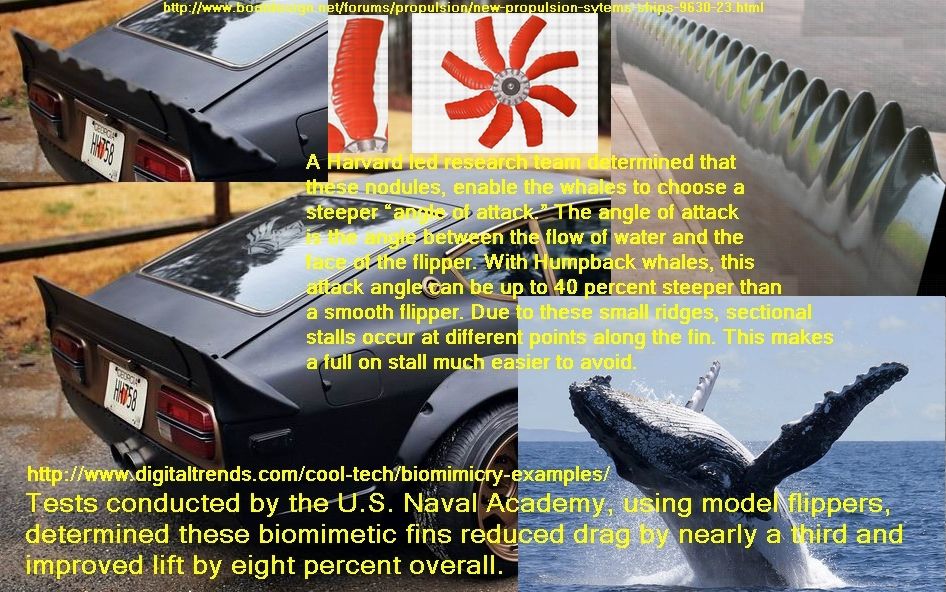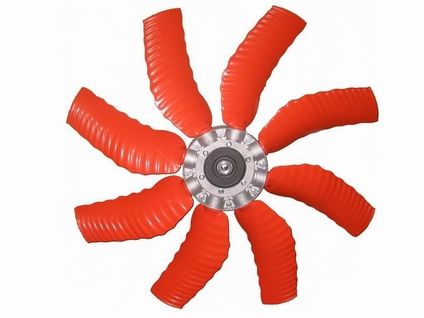I put a little time into this attempting to backtrack on my thoughts.
Background to the concept I presented is needed - and right now.
Biomimicry
Here's 7 of the Best Examples of Biomimicry and Nature-Inspired Design | Digital Trends
Quote:
Many of our modern aerodynamic designs rely on rather basic principles. To obtain optimal lift and minimal drag, sleek edges and clean lines are key. However, throughout the animal kingdom, many species, capable of exceptional lift. The Humpback whale, for example, uses bumpy, tubercle fins for propulsion — which seems rather counterintuitive.
A Harvard led research team determined that these nodules, enable the whales to choose a steeper “angle of attack.” The angle of attack is the angle between the flow of water and the face of the flipper. With Humpback whales, this attack angle can be up to 40 percent steeper than a smooth flipper. Due to these small ridges, sectional stalls occur at different points along the fin. This makes a full on stall much easier to avoid.
Tests conducted by the U.S. Naval Academy, using model flippers, determined these biomimetic fins reduced drag by nearly a third and improved lift by eight percent overall. Whale Power, a company based in Toronto, Canada has already capitalized on this latest tubercle tech. According to MIT, Whale Power’s biomimetic blades help generate the “same amount of power at 10 miles per hour that conventional turbines generate at 17 miles per hour.”
|
Aerodynamics by George Kachadoorian | Photobucket
 And back in 2007............
New propulsion sytems for ships - Page 23 - Boat Design Forums
And back in 2007............
New propulsion sytems for ships - Page 23 - Boat Design Forums

The fan/propeller from 2007 never came into being unfortunately.
The general idea here is to test a straight edge rear spoiler against a tubercle fin edge type.
The goals in mind would be the various angle of attack (vehicle in turns, going up and down hills etc.........) and measure the differences.
These straight edged spoilers we are so familiar with are perhaps just a reflection of man's linear thinking and surrender to manufacturing ease. Nature has some different things in mind apparently, and with 3D printing we can now give it a try.
2008
Bumpy whale fins set to spark a revolution in aerodynamics
http://newatlas.com/bumpy-whale-fins...dynamics/9020/
Quote:
|
March 21, 2008 It seems despite man's endless ingenuity and the incredible modeling power available to inventors through CAD systems, we keep looking to nature to find ever more effective ways of doing things. Millions of years of evolution's trial and error approach have resulted in some incredibly effective designs that are ready to be incorporated into human constructions if we can only identify, understand and replicate them. The random-looking bumps on the humpback whale's flippers have just inspired a breakthrough in aerodynamic design that seems likely to dramatically increase the efficiency and performance of wind turbines, fans, flippers and even wings and airfoils. WhalePower's tubercle technology seems like nothing less than a revolution in fluid dynamics.
|
And the boat tread the article above was posted in including some discussion:
Whale of an idea for marine applications?
http://www.boatdesign.net/forums/boa...tml#post192994